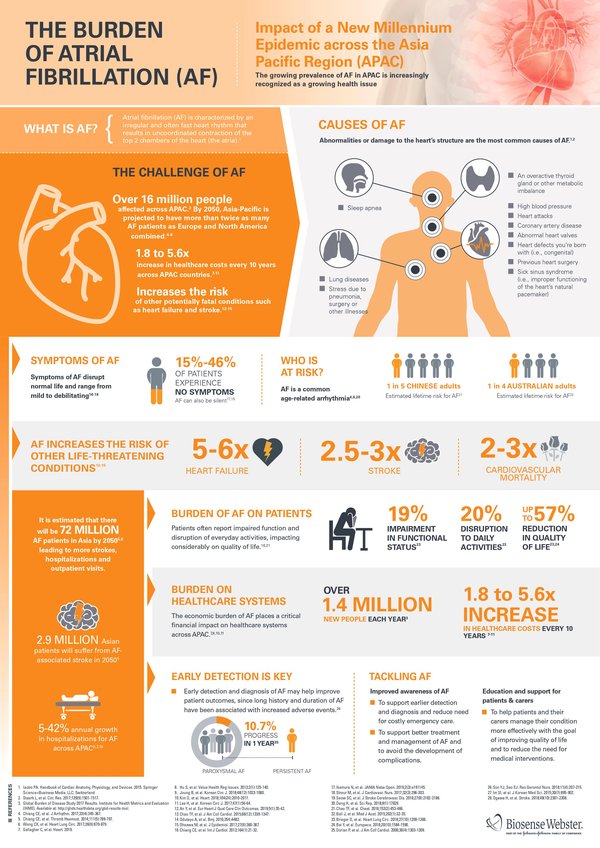Atrial Fibrillation Projected to Affect 72 Million People in Asia Pacific by 2050 According to New Report from Biosense Webster
The prevalence of atrial fibrillation (AF) in Asia Pacific is increasing,currently impacting more than 16 million people in this region.[1]
Current projections show that the number of cases of AF in Asia Pacific will rise to 72 million in Asia Pacific – more than twice as many AF patients than Europe and North America combined.[2] [3] [4]
BANGKOK,Oct. 30,2019 -- Biosense Webster,part of Johnson & Johnson Medical Devices Companies*,has released a report that calls attention to the growing number of people with atrial fibrillation (AF) in Asia Pacific. Launched at the Asia Pacific Rhythm Society (APHRS) annual meeting in Bangkok,the report,entitled "Beyond the Burden: The Impact of Atrial Fibrillation in Asia Pacific," examines both the current state of AF in the region,as well as health risks and future projections for the medical condition.
"This report has a dual purpose – in both illuminating the scale of atrial fibrillation in Asia Pacific,as well as raising awareness amongst the public," said Johnson & Johnson Medical Devices Vice President of Cardiovascular and Specialty Solutions,Asia Pacific Eisuke Yamamoto. "We hope this report goes beyond the burden,informing the public of the symptoms for atrial fibrillation and encouraging them to seek early medical counsel. This is ultimately how we will reduce the impact of atrial fibrillation in Asia Pacific and save lives."
AF is a medical condition causing an abnormal or irregular heart rhythm (arrhythmia) that results in uncoordinated contractions at the top two chambers of the heart.[5] Lack of treatment can increase the risk of other life-threatening conditions such as heart failure,stroke,and cardiovascular mortality.[5] [6] [7] [8] [9] [10]
In addition to the debilitating physical and emotional burden that AF inflicts on patients,the report suggests that the economic burden on healthcare systems across the region is also significant. As the number of patients diagnosed with AF increases by 1.4 million every year,healthcare costs in the region are simultaneously projected to rise by 1.8 to 5.6 times every ten years.[11] [12] [13] [14] [15]
"Early intervention is the resolution for intercepting AF-related health risks before they progress," said Johnson & Johnson Health Economics and Market Access Director Stephanie Lee. "In Thailand alone,AF impacts more than 1.6 million people. As this medical condition continues to affect more people every year,the dialogue between patients and doctors must increase,as well."
One of these early interventions includes catheter ablation,which has been shown to improve quality of life and provide symptomatic relief for selected AF patients.[16]In addition to releasing the report,Biosense Webster previewed several of its latest innovations in ablation technology at the APHRS annual meeting. This includes the CARTO® 3 System Version 7,Biosense Webster's latest cardiovascular 3D mapping technology for electrophysiology diagnosis and treatment.
Biosense Webster is committed to helping people #GetSmartAboutAfib across Asia Pacific.

Atrial Fibrillation Projected to Affect 72 Million People in Asia Pacific by 2050 According to New Report from Biosense Webster
About Johnson & Johnson Medical Devices Companies
At Johnson & Johnson Medical Devices Companies,we are helping people live their best lives. Building on more than a century of expertise,we tackle pressing healthcare challenges,and take bold steps that lead to new standards of care while improving people's healthcare experiences. In surgery,orthopaedics,vision and interventional solutions,we are helping to save lives and paving the way to a healthier future for everyone,everywhere.
About Biosense Webster,Inc.
Biosense Webster,Inc.,part of Johnson & Johnson Medical Devices Companies,is a global leader in the science of diagnosing and treating heart rhythm disorders. The company partners with clinicians to develop innovative technologies that improve the quality of care for arrhythmia patients worldwide. For more information,visit www.biosensewebster.com.
[1]Global Burden of Disease Collaborative Network (2017) Global Burden of Disease Study 2017 (GBD 2017) Results. Seattle,United States: Institute for Health Metrics and Evaluation (IHME),2017. Accessed 2019-07-16. Available from http://ghdx.healthdata.org/gbd-results-tool.
[2]Wong CX,Brown A,Tse HF,et al. Epidemiology of Atrial Fibrillation: The Australian and Asia-Pacific Perspective. Heart Lung Circ. 2017;26(9):870-879.
[3]Chiang CE,Wang KL,Lip GY. Stroke prevention in atrial fibrillation: an Asian perspective. Thromb Haemost. 2014;111(5):789-797.
[4]Chiang CE,Okumura K,Zhang S,et al. 2017 consensus of the Asia Pacific Heart Rhythm Society on stroke prevention in atrial fibrillation. J Arrhythm. 2017;33(4):345-367.
[5]Chao TF,Liu CJ,et al. Age Threshold for Increased Stroke Risk Among Patients With Atrial Fibrillation: A Nationwide Cohort Study From Taiwan. J Am Coll Cardiol. 2015;66(12):1339-1347.
[6]Goto S,Tokai University K,Japan,Oh S,et al. Regional differences in use of antithrombotic therapy for stroke prevention in atrial fibrillation and associated outcomes: European and Asian insights. European Heart Journal. 2019;34(suppl_1).
[7]Jung YH,Kim YD,Kim J,Han SW,Lee KY. Atrial fibrillation in patients with first-ever stroke: Incidence trends and antithrombotic therapy before the event. PLoS One. 2018;13(12):e0209198.
[8]Kongbunkiat K,Kasemsap N,Travanichakul S,Thepsuthammarat K,Tiamkao S,Sawanyawisuth K. Hospital mortality from atrial fibrillation associated with ischemic stroke: a national data report. Int J Neurosci. 2015;125(12):924-928.
[9]Li YG,Lee SR,Choi EK,Lip GY. Stroke Prevention in Atrial Fibrillation: Focus on Asian Patients. Korean Circ J. 2018;48(8):665-684.
[10]Son MK,Lim NK,Kim HW,Park HY. Risk of ischemic stroke after atrial fibrillation diagnosis: A national sample cohort. PLoS One. 2017;12(6):e0179687.
[11]Gallagher C,Hendriks JM,Giles L,et al. Increasing trends in hospitalisations due to atrial fibrillation in Australia from 1993 to 2013. Heart. 2019.
[12]Hu S,Zhan L,Liu B,et al. Economic Burden of Individual Suffering from Atrial Fibrillation-Related Stroke in China. Value Health Reg Issues. 2013;2(1):135-140.
[13]Joung B,Lee JM,Lee KH,et al. 2018 Korean Guideline of Atrial Fibrillation Management. Korean Circ J. 2018;48(12):1033-1080.
[14]Kim D,Yang PS,Jang E,et al. Increasing trends in hospital care burden of atrial fibrillation in Korea,2006 through 2015. Heart. 2018;104(24):2010-2017.
[15]Lee H,Kim TH,Baek YS,et al. The Trends of Atrial Fibrillation-Related Hospital Visit and Cost,Treatment Pattern and Mortality in Korea: 10-Year Nationwide Sample Cohort Data. Korean Circ J. 2017;47(1):56-64.
[16]Mujovic N,Marinkovic M,Lenarczyk R,Tilz R,Potpara TS. Catheter Ablation of Atrial Fibrillation: An Overview for Clinicians. Adv Ther 2017; 34(8): 1897–1917.
Photo - /20191029/2622210-1?lang=0